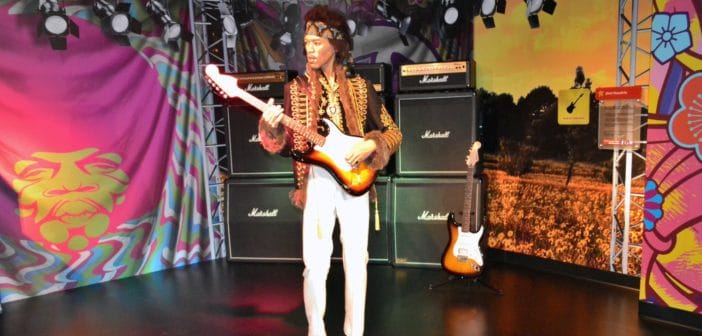 I discovered Jimi Hendrix when I was seven after my Dad played me “Voodoo Child (Slight Return)” on his new tube-amp speaker system, and that was it for me. The way that guitar snaked through the feedback, the possibility of chopping a mountain down with the edge of my hand—all of it appealed to me immensely as a child with my own wild inner world. Hendrix took blues music and somehow transmuted it into something cosmic.
I discovered Jimi Hendrix when I was seven after my Dad played me “Voodoo Child (Slight Return)” on his new tube-amp speaker system, and that was it for me. The way that guitar snaked through the feedback, the possibility of chopping a mountain down with the edge of my hand—all of it appealed to me immensely as a child with my own wild inner world. Hendrix took blues music and somehow transmuted it into something cosmic.
In elementary school, he’d walk around with a broom pretending it was a guitar, and in a way everything in his life story has a similarly predestined feel to it. Drugs and alcohol were present early as well. Jimi’s mother Lucille developed cirrhosis when he was 15 and died in February of that year, after her spleen ruptured. His father Al, a World War II veteran, refused to take him or his brother to the funeral. Instead, he gave the boys whiskey and explained that this was how men dealt with loss. Hendrix got his first real guitar later that same year, and understandably dove into the blues.
He was a quick hand, and later outgrew playing the Southern “Chitlin’ Circuit” before moving to New York. The Rolling Stones’ manager discovered him at a show there and persuaded him to move to London. Shortly after, his band The Jimi Hendrix Experience was born. They took the world by storm with their string of genre-defining albums, “Are You Experienced?”, “Axis: Bold as Love” and “Electric Ladyland” in a span of four years.
Like the instability of his song structures, there was a shadow side to fame. When it came to drugs, Jimi tried it all: marijuana, LSD, amphetamines, ecstasy, sleeping pills, cocaine and heroin. “He was psychologically hooked on drugs,” his once girlfriend Kathy Etchingham said in his biography. “His hair was turning grey and he was losing it.”
But he was particularly unpredictable when he was drunk. Hendrix would trash hotel rooms and start physical fights with men and women alike. He was arrested in Sweden in 1968, where police found him on the floor in a pool of his blood, his hand slashed from breaking a window. He was arrested again in Toronto in 1970, for trying to smuggle heroin and hash through the airport. These episodes all led up to his death on September 18th that same year; after a night of partying, Hendrix took nine Vesparax sleeping pills with a lot of red wine and that was that. Though it was ruled accidental, he took himself out of the world after falling asleep and choking on his own vomit.
His now legendary performance at the Monterey Pop Festival produced a picture of him on his knees, lighting his guitar on fire on stage and summoning the flames up with his hands. It’s the best picture of Hendrix there is because it captured his spirit. Like his life, Hendrix’s songs were experimental and free but equally noisy and chaotic on the way to the joy—he played with fire, and only sometimes literally.
My dad played me that first record 27 years after Hendrix was already in the ground, and strangely enough Hendrix died when he was 27 (like so many other musicians in the so-called 27 Club). It’s just a coincidence, but Hendrix’s otherworldly guitar chops have always encouraged mystical thinking; it’s more comfortable to believe he’s still influencing things here, somehow.
To me and countless others, Jimi Hendrix is the greatest guitarist who ever lived and probably ever will. To say it’s a tragedy that addiction took him while he was in his prime is an understatement; thankfully, he still lives through his music.
Sponsored DISCLAIMER: This is a paid advertisement for California Behavioral Health, LLC, a CA licensed substance abuse treatment provider and not a service provided by The Fix. Calls to this number are answered by CBH, free and without obligation to the consumer. No one who answers the call receives a fee based upon the consumer’s choice to enter treatment. For additional info on other treatment providers and options visit www.samhsa.gov.




